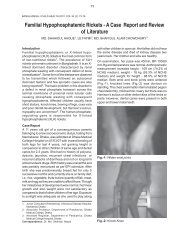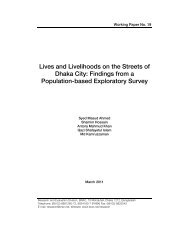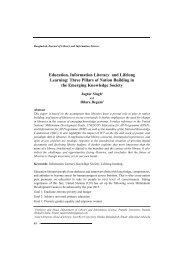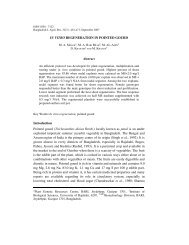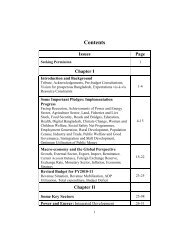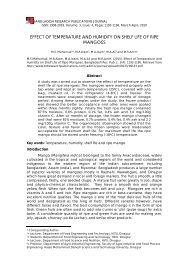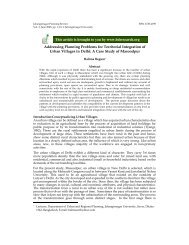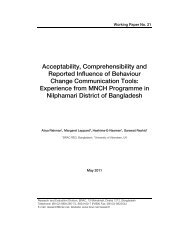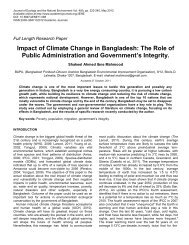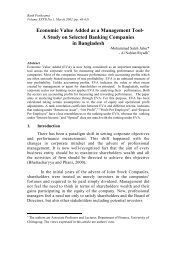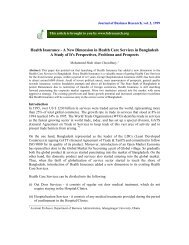9) The moisture c<strong>on</strong>tent of the farmers’ homegrown seed samples ranges from 13.1% to 15.5%,which are higher than that of st<strong>and</strong>ard level <strong>for</strong> wheat (12%). To minimize the metabolicdegradati<strong>on</strong> <strong>and</strong> to c<strong>on</strong>trol mold growth, moisture c<strong>on</strong>tent should ideally be less than 12% inwheat seed, whereas to c<strong>on</strong>trol insect infestati<strong>on</strong>, it should be even less than 9%. At 14%moisture, grains cannot be safely stored bey<strong>on</strong>d 2 to 3 m<strong>on</strong>ths.10) A good numbers of farmers store wheat seed in plastic/metallic drum (45%) <strong>and</strong> the rest of thefarmers in polythene bag (40%). But it was found that a major part (88-93%) of wheat growingfarmers did not practice any intermittent drying <strong>for</strong> safe storage of wheat seed.11) The wheat farmers get lower BCR from wheat grain/seed cultivati<strong>on</strong> compared to Boro rice orhybrid rice. The BCR in Rajshahi from wheat was higher with values, 1.79, 1.81 <strong>and</strong> 1.80 <strong>for</strong>large, medium <strong>and</strong> small farmers, respectively. On the other h<strong>and</strong>, this figure in Dinajpur was1.60, 1.52 <strong>and</strong> 1.42; <strong>and</strong> in Rangpur 1.34, 1.17 <strong>and</strong> 1.25 respectively <strong>for</strong> large, medium <strong>and</strong>small farmers.5.3 Crop: Maize1) The farmers menti<strong>on</strong> different c<strong>on</strong>straints <strong>for</strong> maize cultivati<strong>on</strong>, the major <strong>on</strong>es are high priceof fertilizers, unavailability of quality fertilizer, insect/pest attack (stem borer, cutworm etc.),low grain price, reducing soil fertility, high price of hybrid seed, damage of late planting maizedue to lodging by storm <strong>and</strong> low yield (due to late planting). Moreover, seed producti<strong>on</strong> fromhybrid maize is not possible, market price is under dealer’s c<strong>on</strong>trol <strong>and</strong> existing threshingmethod is too difficult <strong>and</strong> cumbersome.2) A large proporti<strong>on</strong> of the farmers, especially small farmers (40-50%), receive loan <strong>and</strong> inputs(seed <strong>and</strong> fertilizers) <strong>for</strong> maize cultivati<strong>on</strong> from different NGOs (BRAC, PROSHIKA, ASA,TMSS, Karitas etc.) with the c<strong>on</strong>diti<strong>on</strong> of high interest.3) Most of the farmers’ have inadequate knowledge regarding modern cultivati<strong>on</strong> <strong>and</strong> post harvesttechnologies of maize. The farmers should be given appropriate training <strong>on</strong> these issues <strong>for</strong>their capacity building that could encourage them in exp<strong>and</strong>ing maize area.4) The farmers generally sell their maize products in the local market with uncertainty of price.Almost all the intermediate beneficiaries take the advantage from such marketing but thefarmers are virtually deceived.106
6. POLICY IMPLICATIONS AND RECOMMENDATIONS6.1 Producti<strong>on</strong> Phase1) The farmers’ homegrown seed of rice <strong>and</strong> wheat is found to be inferior in quality compared tothat of their respective certified seed; evidently due to farmers’ insufficient knowledge <strong>on</strong> seedproducti<strong>on</strong> technology coupled with low level of input use <strong>for</strong> seed producti<strong>on</strong>. Farmers wouldthere<strong>for</strong>e need to have access to fresh foundati<strong>on</strong> seed <strong>and</strong> fertilizers at af<strong>for</strong>dable prices al<strong>on</strong>gwith appropriate training <strong>on</strong> `Modern <strong>Seed</strong> Technology` including attenti<strong>on</strong> <strong>on</strong> varietalmaintenance, roughing, fertilizer <strong>and</strong> irrigati<strong>on</strong> management, pest c<strong>on</strong>trol, seed processing <strong>and</strong>storage. This would help to sufficiently improve the quality status of their homegrown seed.2) Currently the public seed sector (BADC) could supply a small amount of quality seed of cerealcrops (rice, wheat <strong>and</strong> maize) to the farmers against their huge dem<strong>and</strong>. There<strong>for</strong>e, the seedproducti<strong>on</strong> capacity of BADC should be strengthened through proper planning. Besides, theprivate sectors should be facilitated to produce <strong>and</strong> market quality seed. With establishment oflocal storage facilities, seed cost could be reduced <strong>and</strong> this can increase the efficiency of thesystem as well. Moreover, farmers’ community level seed producti<strong>on</strong> programme should beinitiated through proper inspecti<strong>on</strong> by the <strong>Seed</strong> Certificate Agency (SCA) which would makethe quality seed more af<strong>for</strong>dable to the farmers.3) The current activities of SCA regarding quality c<strong>on</strong>trol of seed are limited due to insufficienttechnical manpower <strong>and</strong> lack of modern laboratory facilities <strong>for</strong> seed testing. The seedcertificati<strong>on</strong> system should be strengthened across the country through increasing technicalmanpower <strong>and</strong> establishing a modern seed testing laboratory at least in each District. The FieldOfficer of SCA should collect spot-samples (including TLS) of cereal seeds <strong>on</strong> a regular basisfrom the seed dealers, seed companies <strong>and</strong> local markets <strong>for</strong> testing. Based <strong>on</strong> the outcomes,legal acti<strong>on</strong> would need to be taken as per to the existing `<strong>Seed</strong> Related Acts <strong>and</strong> Rules`approved by the Ministry of Agriculture to ensure transparency <strong>and</strong> mutual benefits farmers<strong>and</strong> the private seed companies <strong>and</strong> seed traders.4) Government acti<strong>on</strong> is urgently needed towards c<strong>on</strong>trolling seed quality especially in the case ofunlawful seed disseminati<strong>on</strong> from any <strong>for</strong>eign country to Bangladesh.5) Farmers do not use the recommended dose of fertilizers <strong>for</strong> seed crop producti<strong>on</strong>. Measuresshould, there<strong>for</strong>e, be taken to mitigate farmers’ knowledge gap of seed producti<strong>on</strong> regardinguse of balanced fertilizers. Adequate training must be given to the farmers through theAgriculture Service providers <strong>and</strong> motivati<strong>on</strong>al programs like Farmers’ Day, Field Day, ICMprogram, Community level Awareness program, Community discussi<strong>on</strong>, <strong>for</strong>mati<strong>on</strong> of <strong>Seed</strong>Society <strong>and</strong> Radio talk, <strong>and</strong> Televisi<strong>on</strong> program should be regularly c<strong>on</strong>ducted.6) Absolute dependence <strong>on</strong> overseas supply of hybrid maize seed is risky. There<strong>for</strong>e, theGovernment should take measures to initiate hybrid maize seed producti<strong>on</strong> programmme inadditi<strong>on</strong> to the ef<strong>for</strong>t of BARI, <strong>and</strong> seeds should readily be made available to the farmers.7) There is a tendency <strong>for</strong> the farmers to not produce grains/seeds of rice <strong>and</strong> wheat mainly due tolow market price. The computati<strong>on</strong> of producti<strong>on</strong> cost with the statistics given by farmers alsosupports this view. The high price of inputs <strong>and</strong> lack of storage facilities from the viewpoint offarmers’ socio-ec<strong>on</strong>omic c<strong>on</strong>diti<strong>on</strong> are seen to discourage them. Measures should there<strong>for</strong>e be107



